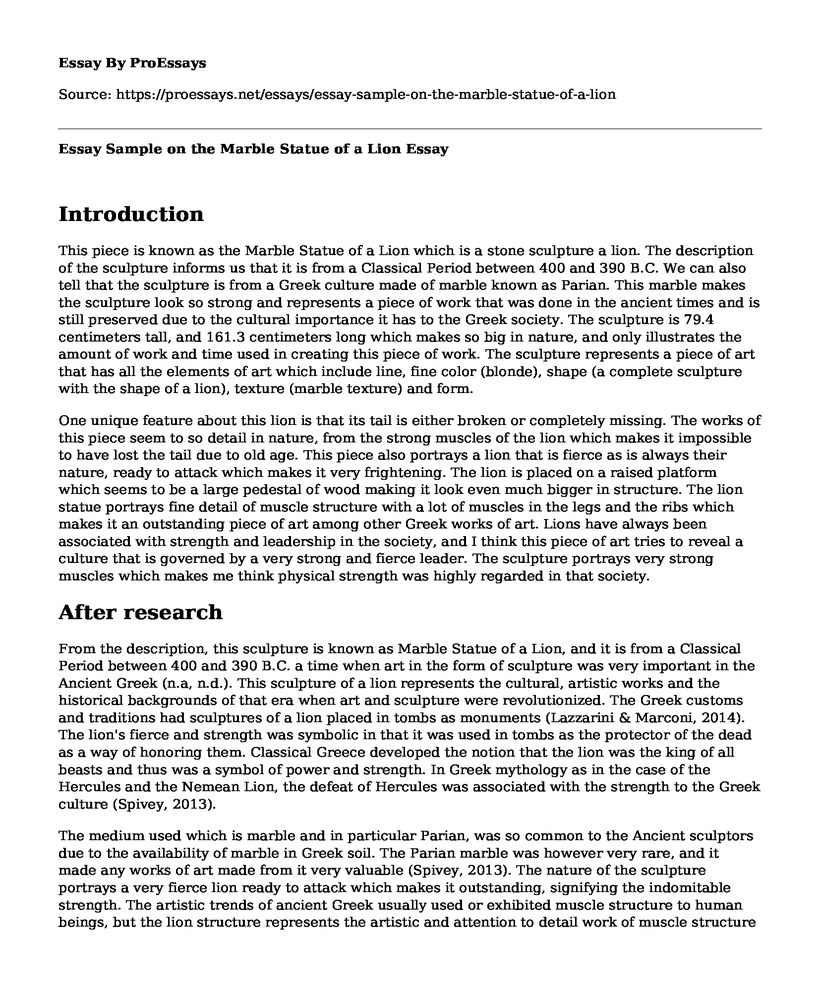Introduction
This piece is known as the Marble Statue of a Lion which is a stone sculpture a lion. The description of the sculpture informs us that it is from a Classical Period between 400 and 390 B.C. We can also tell that the sculpture is from a Greek culture made of marble known as Parian. This marble makes the sculpture look so strong and represents a piece of work that was done in the ancient times and is still preserved due to the cultural importance it has to the Greek society. The sculpture is 79.4 centimeters tall, and 161.3 centimeters long which makes so big in nature, and only illustrates the amount of work and time used in creating this piece of work. The sculpture represents a piece of art that has all the elements of art which include line, fine color (blonde), shape (a complete sculpture with the shape of a lion), texture (marble texture) and form.
One unique feature about this lion is that its tail is either broken or completely missing. The works of this piece seem to so detail in nature, from the strong muscles of the lion which makes it impossible to have lost the tail due to old age. This piece also portrays a lion that is fierce as is always their nature, ready to attack which makes it very frightening. The lion is placed on a raised platform which seems to be a large pedestal of wood making it look even much bigger in structure. The lion statue portrays fine detail of muscle structure with a lot of muscles in the legs and the ribs which makes it an outstanding piece of art among other Greek works of art. Lions have always been associated with strength and leadership in the society, and I think this piece of art tries to reveal a culture that is governed by a very strong and fierce leader. The sculpture portrays very strong muscles which makes me think physical strength was highly regarded in that society.
After research
From the description, this sculpture is known as Marble Statue of a Lion, and it is from a Classical Period between 400 and 390 B.C. a time when art in the form of sculpture was very important in the Ancient Greek (n.a, n.d.). This sculpture of a lion represents the cultural, artistic works and the historical backgrounds of that era when art and sculpture were revolutionized. The Greek customs and traditions had sculptures of a lion placed in tombs as monuments (Lazzarini & Marconi, 2014). The lion's fierce and strength was symbolic in that it was used in tombs as the protector of the dead as a way of honoring them. Classical Greece developed the notion that the lion was the king of all beasts and thus was a symbol of power and strength. In Greek mythology as in the case of the Hercules and the Nemean Lion, the defeat of Hercules was associated with the strength to the Greek culture (Spivey, 2013).
The medium used which is marble and in particular Parian, was so common to the Ancient sculptors due to the availability of marble in Greek soil. The Parian marble was however very rare, and it made any works of art made from it very valuable (Spivey, 2013). The nature of the sculpture portrays a very fierce lion ready to attack which makes it outstanding, signifying the indomitable strength. The artistic trends of ancient Greek usually used or exhibited muscle structure to human beings, but the lion structure represents the artistic and attention to detail work of muscle structure which is evident in the lion's legs and the ribs (Spivey, 2013). This kind of statue with muscle structures was identified with the Ancient Greek during the Classical Period.
The artist's intention was to depict a culture of the Ancient Greek were sculptors used their artistic works as a tool for preserving their traditions and culture. Sculptors used the available materials such as the marble in their works, and human beings were the main subject matter in their works. But this sculpture of a lion indicates how different art could be used in symbolic animals and still manages to protect the culture. The information the artist is trying to depict is so clear and just by observing the sculpture, one can tell his intention that he is trying to depict a very powerful and strong personality or society. Apart from having deep meanings about why the lion was used in this sculpture, this research has a no different meaning from what I gathered about the artistic trying to depict strength.
References
Lazzarini, L., & Marconi, C. (2014). A new analysis of major Greek sculptures in the Metropolitan Museum: petrological and stylistic. Metropolitan Museum Journal, 49(1), 117-140.
n.a, n.d Retrieved from https://www.metmuseum.org/art/collection/search/248140?searchField=All&sortBy=relevance&ft=greek&offset=0&rpp=20&pos=5
Spivey, N. (2013). Greek sculpture. Cambridge University Press.
Cite this page
Essay Sample on the Marble Statue of a Lion. (2022, Oct 29). Retrieved from https://proessays.net/essays/essay-sample-on-the-marble-statue-of-a-lion
If you are the original author of this essay and no longer wish to have it published on the ProEssays website, please click below to request its removal:
- Book Review Example: The Massacre at El Mozote: A Parable of the Cold War by Mark Danner
- Compare and Contrast Mao Zedong and Kim Jong Un's Method of Enforcement
- Russian Threats and Western Actions Essay
- Basquiat, Da Vinci and Sor Juana Paper Example
- Research Paper on Malcolm X: Father of Black Nationalism & Separatism Movement
- The American Slavery Period: A Dark History for Minority Denominations - Essay Sample
- Essay Example on Plato: Father of Western Philosophy & Redefining Virtues







